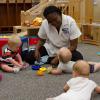- Identify ways the environment can help support the development of self-regulation.
- Explore how the environment can help provide extra support and prevent challenging behaviors.
- Learn ways to support infants, toddlers, and families through consistent and responsive routines and transitions.
Learn
Know
Take a moment to evaluate your current environment. What words would you use to describe it? Did you use words to describe the lighting, the colors, the sounds, or the temperature? The environment includes not only the physical space and furniture arrangement, but the people, routines, schedules, experiences, and emotional tone of the space.
Young children develop foundational skills for self-regulation in the first five years of life, which means caregivers and early-childhood teachers play important roles in helping young children regulate their thinking and behavior. As an infant and toddler caregiver, you have an opportunity to continue to explore the ways the environment can be used as a powerful tool to support the development of self-regulation and to prevent challenging behaviors. For very young infants who cannot move themselves from one activity to another, the environment is particularly important. The physical environment, group size, daily schedules, plans, and routines should encourage infants’ and toddlers’ sense of security and safety.
Creating Environments that Support Infants and Toddlers
The environment is a crucial element of infant and toddler care, and it is the adult caregiver who decides what infants and toddlers see, touch, and hear. They make decisions about how much fresh air, sunlight, and exercise infants and toddlers will have. Adult caregivers create the physical space, select materials and toys, and provide interactions and experiences that help make up the day for infants and toddlers. Infants and toddlers rely on adults to create an environment that supports relationships, encourages responsive care from adults, and is appropriate for their age, development, interests, and culture.
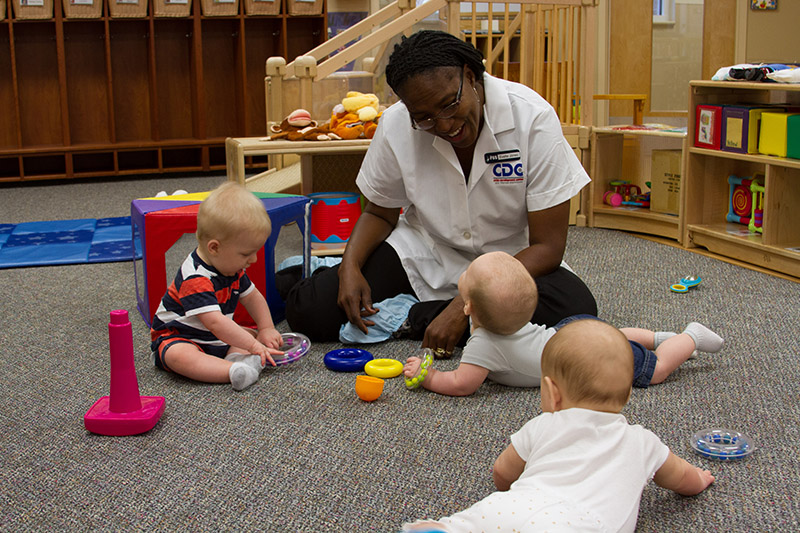
From the moment they are born, infants attend to multiple sensations, such as lights, sounds, movement, hunger, fatigue, etc. The ways young children perceive and respond to sensory information affects how they respond to the world around them, including people, and their ongoing development of self-regulation. For example, a young child who is more sensitive to sound may easily become overwhelmed in an early-care and learning setting where music is always played. Caregivers may notice this young child hitting peers, having trouble making eye contact, and playing with a toy for an extended period of time during times when the noise level is higher than usual.
As an infant and toddler caregiver, it is important to stay connected with a young child’s family. Connections with families help you find ways to support infants’ and toddlers’ unique needs, which helps them regulate their behaviors and feel safe and successful in the care setting. Ongoing observation can also provide clues about how a young child is receiving, making sense of, and responding to the environment.
Below are some examples of how the environment can directly impact social development, and strategies to consider within your early-care and learning environment to support self-regulation and prevent challenging behavior:
- Responsive, consistent routines and schedules help strengthen relationships between infants, toddlers, and their caregivers. This provides security and a sense of control by letting infants and toddlers know what is coming next, which allows them to relax and explore their environment. Well-developed, clear, and consistent schedules and routines can help keep toddlers engaged in the day’s activities, prevent distress, and reduce anxiety in young children, especially those who are resistant to change or surprises.
- Observe for signs of overstimulation. Provide quiet spaces for infants and toddlers who may be feeling overwhelmed or use white noise to help reduce loud or distracting sounds. Post family photos that infants and toddlers can see throughout the day.
- Talk about families during the day and let infants and toddlers know their parents are thinking about them.
- Provide toys and materials that are responsive to young children’s development and interests.
- Design the learning environment to promote both independence and social interactions. Place materials on low, open shelves, and ensure there are enough similar materials for children to play together.
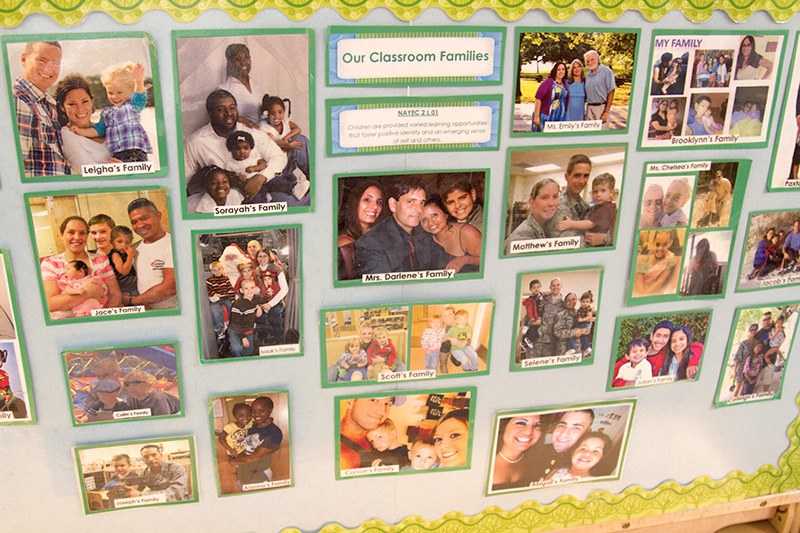
Considering Schedules and Routines
Managing time and the sequence of events that occur each day is an important part of positive guidance. A regular schedule can prevent behavioral outbursts and reduce anxiety in children. Providing structure and predictability helps everyone know what is to be expected throughout the day. Below are some suggestions for your infant and toddler environment:
- Post a visual schedule of the day’s events at young children’s eye level so they are aware of what is coming next, helping them to understand the sequence of events.
- Use multiple strategies during transitions, such as providing a picture that shows young children cleaning-up while saying, “When the bubbles stop, it will be time for clean-up.”
- Prepare infants and toddlers by talking about changes in advance. Some infants and toddlers will notice changes more than others and may feel stressed by the changes. In addition, it may be useful to review past activities with toddlers, assisting them in making connections from past events for a sense of structure throughout their day.
- Invite infants and toddlers to take part in daily routines. For example, you may let an infant hold their clean diaper, or invite a toddler to put out the plates on the table. By allowing infants and toddlers to participate, you are showing them that they are important.
- Help support children and families during arrival times by providing them space and time to say “good-bye.” Sometimes a child may become quickly engaged in the classroom after they arrive, and it may be tempting to have the family member “sneak out.” However, remember that separations from loved ones can be challenging for infants and toddlers, so it is best that they experience this transition to ward off future distress. If the child does become upset at drop off, work on a separation plan with the family in order to support both the child and the caregiver.
- Ask families about their routines at home and what they feel might help during transitions, in particular hellos and good-byes. Children may have security items, like a blanket or stuffed animal that help them to feel calm and secure. Many families have their own practices regarding routines. By working to incorporate the routines of the families in your program, you are being culturally responsive.
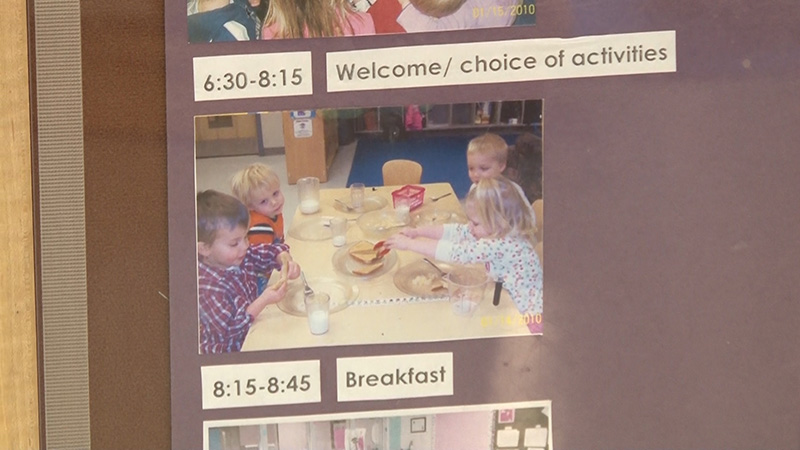
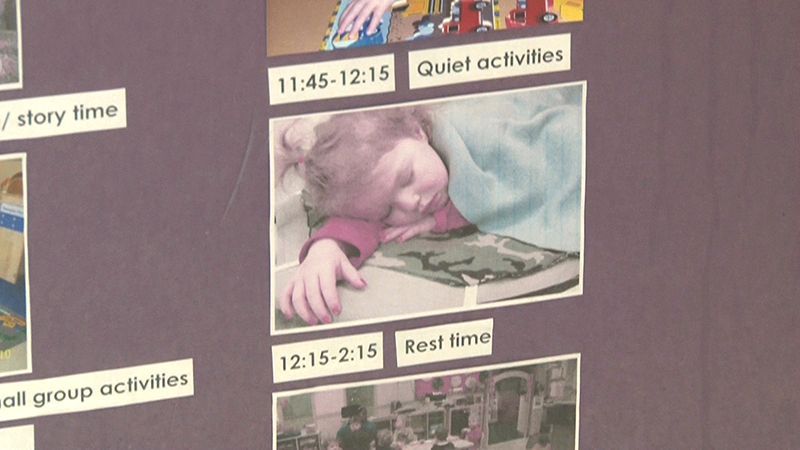
Considering Physical Design
In a program for infants and toddlers, it is important to engage young children with the environment, including the people around them. Comfortable furnishings and soft surfaces with interesting patterns provide visual interest and a safe place for young children to explore. Incorporating separate spaces for play, frequently rotating materials, and providing duplicates of toys will help to avoid conflicts, hurt feelings, and tantrums. Also, think about how your space looks to infants, toddlers, and their families. Children can become visually overstimulated too. In order to make the space feel welcoming, calm, and home-like, keep the décor minimal. Additional ideas and information can be found in both the Learning Environments and Social Emotional Development courses.
When a child begins to exhibit a challenging behavior, it is easy to try to think of ways to fix that behavior. As discussed in the Learning Environments course, the environment is considered to be the child’s third teacher (with parents and child care providers being their first and second teachers), according to the Reggio Emilia approach to early learning. What this means is that a caregiver should consider what changes could be made to the environment to support the child exhibiting challenging behavior. It is important to evaluate all aspects of the environment, including the people and the schedule or routines. It is possible that a child prefers how a particular caregiver rocks them to sleep or that turning the lights down before nap time is a helpful cue for them to know it is time to rest. Other considerations could be the design of the space (moving shelves to prevent running) or the availability of materials.
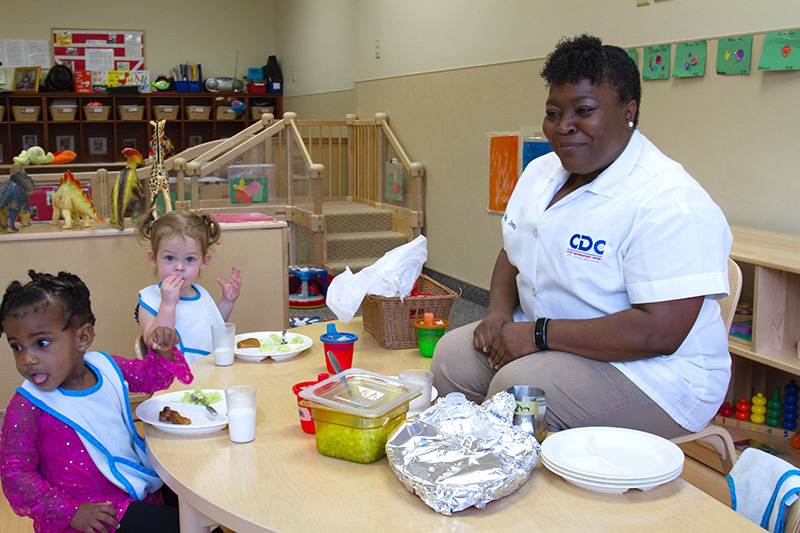
Preventing Challenging Behaviors in the Infant Toddler Environment
Infants and toddlers exhibit challenging behaviors for a variety of reasons. As an infant and toddler caregiver, you have opportunities to understand the reasons for and the meaning behind these behaviors and to offer support and guidance in a nurturing environment. Caregiving environments, health, developmental strengths and needs, and temperament all influence young children’s behaviors. Even when developmentally appropriate supports and strategies are in place, some infants and toddlers will require an individualized approach. Let’s use biting as an example:
- Temperament: Adult caregivers can consider different ways to support this child’s temperament. For example, if an infant or toddler feels anxious in new situations, the adult caregiver can give extra support when there is going to be a change in the routine.
- Environment: Adult caregivers can change the environment to encourage additional positive behaviors. For example, if a toddler bites during cleanup time, caregivers can involve the toddler in helping the adult with a specific cleanup task. Or, if the environment is over stimulating, the caregivers might dim the lights, reduce the noise level, separate children into smaller groups, or create a designated space for toddlers to recharge and relax with the support of an adult.
- Communication: A young child’s biting may be their most effective form of communication. When they bite, they get a reaction from their peers and their caregivers. Adults can help support the development of new communication skills, such as, “Stop!” or “Help!” Sometimes, a young child might bite as a form of greeting. In this instance, adult caregivers can support the child to learn other ways to say hello.
- Personal Needs: Eating and resting times may need to be adjusted if a young child seems to be biting when hungry or tired. Also, toddlers should have access to drinking water throughout the day. Often, young children may bite when they are getting new teeth. Consider offering the child a teething toy or cold, wet washcloth to chew on. Be sure to use messages such as, “Do your teeth hurt? You can bite this toy,” instead of “Stop biting,” as a means of redirection. We will discuss redirection more in Lesson 4.
- Strong emotions: Adult caregivers can help young children learn to identify and express strong emotions by labeling and validating them. For example: “You smiled when he gave you that block. Did that make you happy?” or, “I also feel so disappointed that it’s raining outside!”
- Stress: Adult caregivers can continue to recognize signs of stress in infants and toddlers and provide supportive words, touch, or items to offer additional comfort.
For additional support in finding the most responsive and effective approaches to a young child’s behavior, talk with your trainer, coach, or administrator about your program’s policies regarding responding to challenging behavior. Also, discuss ways you can continue to communicate with families to learn about the infant’s or toddler’s world.
Addressing the Needs of All Children
Children in your classroom who have developmental delays or who experience challenging life events or circumstances may also experience challenges with behaviors. These challenges may influence their ability to benefit from high-quality early education and to engage in positive social interactions with peers and adults. Even though challenging behaviors are typical for young children, some children show persistent challenging behaviors that may affect their overall early care and learning experience. It is important to provide children with the support they need so they can benefit as much as possible from their early learning experiences. For these young children, you may need to adapt your routines, program environment and experiences to enable them to be successful. Think about large group activities, transitions, lunch and snack time, potty time, free play time indoors and outdoors, or other routine and program events. What are you doing during these times to ensure you address the needs of all children in your program?
You will also have to work with children’s families to ensure consistency between the early care and learning environment and home. Families may benefit from your strategies that support children’s positive behaviors. Some infants and toddlers in your care may have conditions that affect their social-emotional development, including developmental delays, autism, neurological and perceptual disorders, or language and communication delays. Children with Individualized Education Programs (IEPs) or Individual Family Service Plans (IFSPs) have a specific plan to help them meet their education or developmental goals. Very often, these children will need changes or adaptations to their schedule, routine, and classroom environment.
It is critical that you get to know the children in your program to be able to support their successful participation in your program experiences. Make sure all children and families feel welcome and involved. The Kids Included Together (KIT) program can be a valuable resource for ideas. You can also consider Building Blocks and Cara’s Kit. These resources from the Council for Exceptional Children Division for Early Childhood provide practical, real-world ways to help children succeed in their environments.
See
Preventing Challenging Behavior: Transition Strategies
Do
Continue to consider the many ways you can create an environment for infants and toddlers that both supports the development of self-regulation and prevents challenging behavior:
- Provide consistent and predictable expectations and care routines.
- Have duplicates of favorite toys and materials.
- Rotate toys regularly to support new interests.
- Provide materials and experiences related to infants’ and toddlers’ interests or emerging skills.
- Minimize waiting time during transitions.
- Provide safe opportunities for exploration and independence.
- Talk with infants and toddlers about their day and what they will be doing next. Provide warnings before transitions to help infants and toddlers prepare.
- Provide multiple sensory activities.
- Offer books, pictures or other materials that talk about or demonstrate different emotions. These items provide opportunities to help label emotions and discuss appropriate ways to express them.
Explore
It can be useful to ask a trainer, coach, or administrator to observe your classroom environments and give you feedback on how these environments function. You can use this information to reflect on the appropriateness of your classroom spaces. Read and complete the Observing Environments Activity. Share and discuss the findings with your trainer, coach, or administrator.
Apply
Review the Environment Planning document from the Center on the Social and Emotional Foundations for Early Learning. Using this document, think about your program environment and how each space supports the social and emotional development of infants and toddlers in your care. Pay attention to potential improvements to your environment and examples of things you can work on modifying. You can also review the Infant and Toddler Spaces document to support your reflection of your own environment. When you are finished share your work with your trainer, coach, or administrator.
Glossary
Demonstrate
Blair, C. (2002). School readiness: Integrating cognition and emotion in a neurobiological conceptualization of children’s functioning at school entry. American Psychologist, 57(2), 111-127.
Brenner, M. I. (2001). When no gets you nowhere: Teaching your toddler and child self-control. Prima Publishing
Greenman, J., Stonehouse, A., & Schweikert, G. (2008). Prime times: A handbook for excellence in infant and toddler programs. Redleaf Press.
Honig, A. (2005). Behavior guidance for infants and toddlers. Southern Early Childhood Association.
Koralek, D. G., Dombro, A. L., & Trister Dodge, D. (2005). Caring for infants and toddlers. Teaching Strategies.
Williamson, G. G., & Anzalone, M. E. (2001). Sensory integration and self-regulation in infants and toddlers: Helping very young children interact with their environment. ZERO TO THREE.


